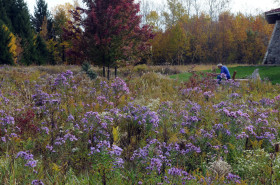 A group of foresters stopped by Crossroads this week for an informal look at our sick trees. Yes, we have the dreaded emerald ash borer. Oddly, our infested trees look pretty normal for this time of year, but our healthy trees look simply awful. Admittedly, many of our evergreens experience winter burn this year, but they’ve had a nice moist summer to recover and they were perking up, but now, the white pines and arbor vitae seem to be losing about a quarter of their needles.
A group of foresters stopped by Crossroads this week for an informal look at our sick trees. Yes, we have the dreaded emerald ash borer. Oddly, our infested trees look pretty normal for this time of year, but our healthy trees look simply awful. Admittedly, many of our evergreens experience winter burn this year, but they’ve had a nice moist summer to recover and they were perking up, but now, the white pines and arbor vitae seem to be losing about a quarter of their needles.That is because our white pines and arbor vitae actually are losing about a quarter of their needles. Oh, the outside foliage is still nice and green but the inner needles are brown, brittle, and ugly. And it doesn’t take much of a wind to bring a shower of dead needles from every tree. We aren’t worried. This happens every year. It’s perfectly natural.
I suppose it is the word “evergreen” that confuses people, who assume that if a tree is an evergreen, the needles will stay green for EVER…like maybe until eternity or something.
Understand that needles on pines and sprigs of cedar actually are leaves. Just like the leaves of deciduous trees, evergreen needles make food. They take energy of the sun and chemically combine it with water and carbon dioxide to produce sugar compounds through the miraculous process called photosynthesis.
First year needles, fresh from the bud, are very, very good at photosynthesis. They are so efficient at making food that they manufacture more than they can use so their output is used by the rest of the tree to make the wood, branches, and cones for future years.
Second year needles are not quite as efficient as fresh needles, but they are more efficient that needles which have been on the tree for three or four years. Not only are the younger needles more efficient, but also, because of the growing patterns of evergreens, young needles get the most sunlight.
While some evergreens are able to hold needles for as many as eight years, the normal useful life of an average needle on an average tree in this region is three to four years. When needles stop being useful to the tree, they turn brown and drop. Evergreens shed worn-out needles throughout the year, but in autumn the needle drop it is alarmingly obvious. But it is normal and even beneficial because a buildup of needles provides a nice mulch for the winter months ahead.
Naturalist led-color hikes will visit both evergreen and deciduous forests at the Crossroads Preserve and the Ida Bay Preserve. Because this is our first autumn since The Nature Conservancy transferred this amazing property to us, we are most eager to see just how colorful it is. Hikes are free and open to the public.
Friends of Crossroads have changed the day and time of their monthly meetings. They will now be meeting at 6:00 on the second Tuesday of each month. At the October, group will be looking ahead to volunteer opportunity for fall and winter. What hasn’t changed is that visitors welcome. The group meets in the Collins Learning Center.
.

